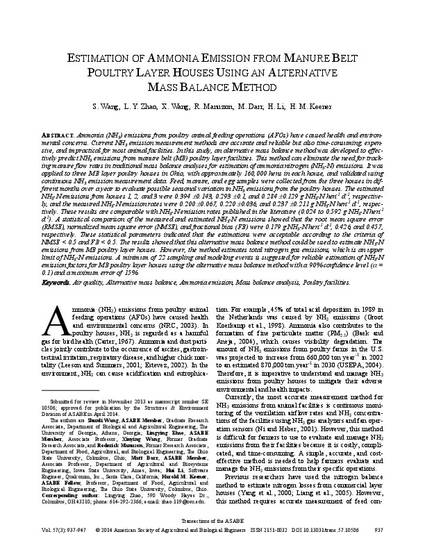
Ammonia (NH3) emissions from poultry animal feeding operations (AFOs) have caused health and environmental concerns. Current NH3 emission measurement methods are accurate and reliable but also time-consuming, expensive, and impractical for most animal facilities. In this study, an alternative mass balance method was developed to effectively predict NH3 emissions from manure belt (MB) poultry layer facilities. This method can eliminate the need for tracking manure flow rates in traditional mass balance analyses for estimation of ammonia nitrogen (NH3-N) emissions. It was applied to three MB layer poultry houses in Ohio, with approximately 160,000 hens in each house, and validated using continuous NH3 emission measurement data. Feed, manure, and egg samples were collected from the three houses in different months over a year to evaluate possible seasonal variation in NH3 emissions from the poultry houses. The estimated NH3-N emissions from houses 1, 2, and 3 were 0.394 ±0.143, 0.293 ±0.1, and 0.284 ±0.129 g NH3-N hen-1 d-1, respectively, and the measured NH3-N emission rates were 0.200 ±0.067, 0.220 ±0.036, and 0.237 ±0.211 g NH3-N hen-1 d-1, respectively. These results are comparable with NH3-N emission rates published in the literature (0.024 to 0.592 g NH3-N hen-1 d-1). A statistical comparison of the measured and estimated NH3-N emissions showed that the root mean square error (RMSE), normalized mean square error (NMSE), and fractional bias (FB) were 0.179 g NH3-N hen-1 d-1, 0.426, and 0.457, respectively. These statistical parameters indicated that the estimations were acceptable according to the criteria of NMSE < 0.5 and FB < 0.5. The results showed that this alternative mass balance method could be used to estimate NH3-N emissions from MB poultry layer houses. However, the method estimates total nitrogen gas emissions, which is an upper limit of NH3-N emissions. A minimum of 22 sampling and modeling events is suggested for reliable estimation of NH3-N emission factors for MB poultry layer houses using the alternative mass balance method with a 90% confidence level (α = 0.1) and a maximum error of 15%.
Available at: http://works.bepress.com/matthew_darr/52/

This article is from Transactions of the ASABE 57 (2014): 937–947, doi:10.13031/trans.57.10506. Posted with permission.